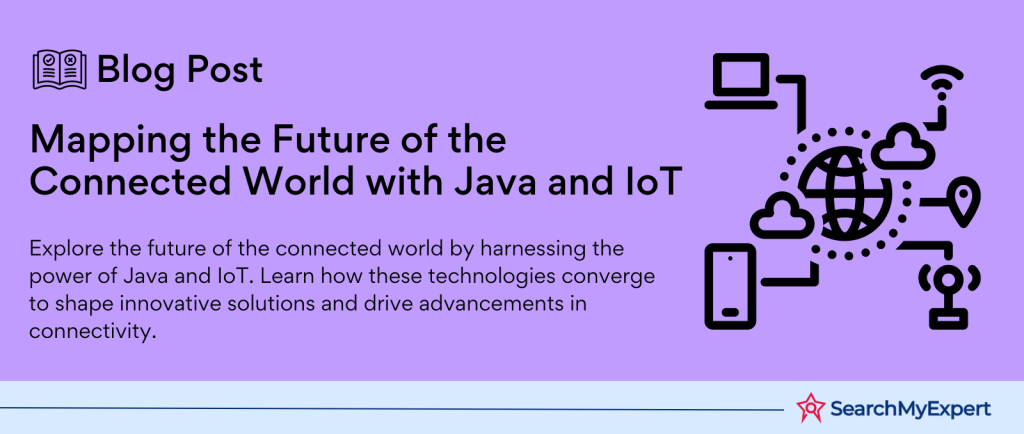Java Web Development and IoT: The Future is Now
Unraveling the Power of Java and IoT
What is Java Web Development?
Java Web Development is the art and science of building dynamic and interactive web applications using Java technologies. It’s a vast domain, incorporating various technologies like:
- Servlets:
The backbone of Java web development, managing requests and responses. - JavaServer Pages (JSPs): Simplifying content generation, blending HTML and Java seamlessly.
- Spring Framework:
A powerhouse for enterprise applications, providing a comprehensive programming and configuration model.
Java web development’s strength lies in its robustness, cross-platform capabilities, and extensive community support. It’s the go-to choice for creating sophisticated web applications that are scalable, secure, and efficient.
What is the Internet of Things (IoT)?
The Internet of Things (IoT) is a revolutionary concept, marking the next step in the internet’s evolution. It revolves around:
- Connected Devices: From smart thermostats to industrial machines, IoT connects a wide array of devices.
- Data Exchange: These devices continuously collect and exchange data, offering insights and control like never before.
- Networks: IoT leverages various networks, making remote monitoring and management a reality.
IoT is transforming how we interact with the physical world, bringing an unprecedented level of automation and efficiency.
Bridging the Gap: Java and IoT
Java’s role in IoT is pivotal. It bridges the gap between intricate web applications and the tactile world of IoT. Here’s how:
- Universal Language:
Java’s platform independence makes it ideal for the diverse ecosystem of IoT. - Security:
Java’s robust security features ensure safe data handling in IoT applications. - Scalability:
Java scales seamlessly, catering to the growing network of IoT devices.
The fusion of Java Web Development and IoT opens a realm of possibilities, from smart homes to industrial automation, making the world more connected and intelligent.
Advantages of Java for IoT Development
Platform Independence: “Write Once, Run Anywhere” Unleashed
Java stands out with its “Write Once, Run Anywhere” (WORA) principle. This is crucial in IoT for several reasons:
- Device Diversity: IoT thrives on a variety of devices, each with unique hardware and OS. Java’s WORA ensures compatibility across this spectrum.
- Resource Constraints: IoT devices often have limited resources. Java’s efficient JVM (Java Virtual Machine) adapts to these constraints, offering consistent performance.
- Ease of Development: Developers write code once, deploy it on multiple devices, saving time and resources.
Java’s platform independence is a game-changer in the fragmented world of IoT, ensuring seamless integration and operation.
Robustness and Security: The Java Fort
Java’s security and robustness are unmatched, especially vital for IoT applications dealing with sensitive data.
- Security Features:
Java provides a secure runtime environment, safeguarding against common vulnerabilities. - Mature Libraries:
Java’s extensive libraries are time-tested, ensuring reliable and stable IoT applications. - Error Handling:
Java’s strong error-handling mechanisms prevent system crashes, crucial in critical IoT operations.
In the IoT landscape, where data integrity and system stability are paramount, Java’s robustness and security are invaluable assets.
Large Ecosystem and Community: A Java IoT Universe
Java’s ecosystem is a treasure trove for IoT developers:
- Rich Libraries and Frameworks:
Tailored for IoT, these tools simplify complex tasks, from sensor data processing to device management. - Active Community: Java’s vast community offers unparalleled support, sharing knowledge and solutions.
- Continuous Innovation: Java’s ecosystem is ever-evolving, fueled by contributions from developers worldwide, keeping it at the forefront of IoT advancements.
This extensive ecosystem and vibrant community make Java not just a programming language but a thriving environment for IoT innovation.
Building IoT Applications with Java
Java Frameworks for IoT: The Backbone of Innovation
Java’s versatility in IoT is largely due to its powerful frameworks:
- Spring Boot:
Simplifies the development of stand-alone, production-grade applications. In IoT, it’s used for rapid development and easy deployment. - Eclipse Kura: An IoT gateway framework, providing a platform for building smart edge devices. It handles network configurations, communication, and data management.
- Vert.x:
A toolkit for building reactive applications on the JVM. It’s ideal for IoT, providing a responsive and resilient system.
These frameworks empower developers to build robust and scalable IoT applications, streamlining the development process and enhancing functionality.
Data Acquisition and Processing: Java’s Analytical Prowess
Java excels in handling the data-intensive nature of IoT:
- Data Acquisition:
Java interfaces with sensors and devices to gather real-time data, crucial for IoT systems. - Real-time Processing:
Libraries like Apache Flink and Spark enable real-time data processing and analytics, turning raw data into actionable insights. - Efficiency:
Java’s efficient processing capabilities ensure quick analysis, vital for timely decision-making in IoT environments.
Java’s ability to acquire and process data swiftly and efficiently makes it a cornerstone in IoT applications.
Web Interfaces and Visualization: Java’s Artistic Side
Java’s web development tools bring IoT data to life:
- User Interfaces: Java frameworks aid in creating intuitive interfaces for monitoring and controlling IoT devices.
- Data Visualization:
Java’s rich libraries enable the development of interactive dashboards, presenting complex IoT data in a digestible format. - Connectivity: Seamlessly integrates with web technologies, enabling remote access and control of IoT systems.
Java’s proficiency in creating dynamic web interfaces and visualizations enhances user experience, making IoT data more accessible and actionable.
Challenges and Considerations in Java IoT Development
Resource Constraints: Efficient Coding is Key
In the world of IoT, devices often face memory and processing limitations. This imposes significant challenges for Java developers:
- Efficient Coding:
Java code must be optimized for minimal memory and processing footprint. - Lightweight Frameworks: Choosing frameworks that are less resource-intensive is crucial.
- Performance Tuning:
Regular performance evaluations to ensure optimal resource usage.
Java developers must navigate these constraints creatively, ensuring that applications are both powerful and resource-efficient.
Security Concerns: Safeguarding the IoT Sphere
IoT systems are particularly vulnerable to security breaches. Java offers several solutions:
- Inherent Security Features:
Java’s built-in security features like sandboxing and bytecode verification play a crucial role. - Encryption and Authentication: Leveraging Java’s advanced encryption and authentication mechanisms is vital for protecting data.
- Regular Updates and Patches: Keeping Java environments updated is crucial to guard against emerging threats.
Security in IoT is non-negotiable, and Java’s robust security features are key in building a secure IoT ecosystem.
Scalability and Interoperability: Balancing Act in IoT
Scaling IoT applications and ensuring interoperability among diverse devices and protocols is a complex task:
- Scalability: Java applications must be designed to scale seamlessly with the growing number of IoT devices.
- Interoperability: Ensuring Java applications work harmoniously with various devices and protocols is a significant challenge.
- Flexible Architecture: Adopting a flexible architectural approach is essential to accommodate diverse IoT ecosystems.
Java developers must strike the right balance between scalability and interoperability to ensure the smooth functioning of IoT systems.
Real-World Examples of Java in IoT
Smart Homes: Comfort and Security at Your Fingertips
Java is revolutionizing the smart home sector:
- Home Automation:
Java enables the integration of various home devices, offering seamless control over lighting, heating, and more. - Energy Management: Java-powered systems manage energy consumption efficiently, leading to cost savings and environmental benefits.
- Security:
Java applications enhance home security systems with features like automated alarms and surveillance.
Java’s role in smart homes is making life more convenient, secure, and energy-efficient.
Industrial IoT: Elevating Industrial Efficiency
Java’s impact on industrial IoT is profound:
- Predictive Maintenance:
Java-driven applications predict equipment failures, saving costs and preventing downtime. - Remote Monitoring:
Java enables monitoring of industrial processes from anywhere, ensuring continuous operation. - Optimization: Java applications analyze data to optimize production processes, improving efficiency and output.
Java is a cornerstone in transforming industrial operations, making them more efficient and predictive.
Wearable Devices: A New Era of Personal Technology
Java is at the heart of wearable technology:
- Data Collection:
Java applications facilitate efficient data collection from sensors embedded in wearable devices. - Data Analysis:
Java’s powerful libraries analyze health and fitness data, providing valuable insights. - User Interface: Java ensures a smooth user experience, with interactive and responsive interfaces on wearable devices.
Java’s role in wearable devices is enhancing personal health and fitness technology, making it more intuitive and insightful.
Future Trends and Opportunities in Java IoT
Edge Computing and Distributed Systems: Java at the Forefront
The role of Java in edge computing and distributed systems is expanding:
- Real-time Processing:
Java’s efficiency makes it ideal for processing data at the edge, close to where it’s generated. - Distributed Systems: Java facilitates the development of distributed IoT applications, enhancing performance and reliability.
- Adaptability: Java’s adaptability to various environments makes it a natural fit for edge computing.
Java’s involvement in edge computing is pivotal for real-time IoT applications, enhancing responsiveness and reducing latency.
Artificial Intelligence and Machine Learning: Java’s New Frontier
Java’s integration with AI and ML is unlocking new possibilities:
- Predictive Analytics: Java-based AI models predict trends and behaviors in IoT data, providing foresight and insights.
- Anomaly Detection: Java with ML can detect anomalies in real-time, enhancing IoT security and efficiency.
- Intelligent Decision-Making:
Java-powered AI algorithms enable IoT systems to make autonomous decisions, improving effectiveness.
Java’s role in AI and ML is transforming IoT into a more intelligent and proactive technology.
New Technologies and Innovations: Java’s Continuous Evolution
Java is adapting to emerging trends in IoT:
- Blockchain: Java is exploring blockchain applications in IoT for enhanced security and data integrity.
- Low-Power Networking:
Java’s ability to work with low-power networking protocols is crucial for energy-efficient IoT devices. - Innovation: Java continues to evolve, adapting to new technologies and maintaining its relevance in the IoT ecosystem.
Java’s adaptability to new technologies like blockchain and low-power networking is ensuring its continued significance in the ever-evolving IoT landscape.
Embracing Java’s Potential in IoT
Java’s role in IoT development is not just prominent but transformative. Its versatility, security, and robust ecosystem make it a powerhouse in this dynamic field. From smart homes and industrial applications to wearable technologies, Java has proven to be a driving force in IoT innovation.
The future looks bright for Java in IoT. The convergence with technologies like edge computing, AI, and ML, along with Java’s adaptability to new trends like blockchain and low-power networking, points to an era of unprecedented advancements. These developments open up a world of possibilities, pushing the boundaries of what can be achieved in IoT.
For those intrigued by the potential of Java-powered IoT solutions, the journey has just begun. The field is ripe for exploration, innovation, and learning. Whether you’re a developer, a tech enthusiast, or a visionary entrepreneur, diving into Java IoT development promises not just challenges but also exciting opportunities to shape the future of technology.
Conclusion
Java’s role in IoT is a saga of innovation and adaptability. Its platform independence, robust security, and vast ecosystem make it an integral player in IoT’s narrative. As IoT evolves with edge computing, AI, and emerging technologies like blockchain, Java’s versatility ensures it remains at the forefront of this transformation. For developers and tech enthusiasts, Java in IoT is a realm brimming with potential and opportunities. It’s a journey of continuous learning and groundbreaking development, shaping the future of our interconnected world.
Revolutionize your digital strategy with our Java Development Service.
Table of Contents
Toggle






